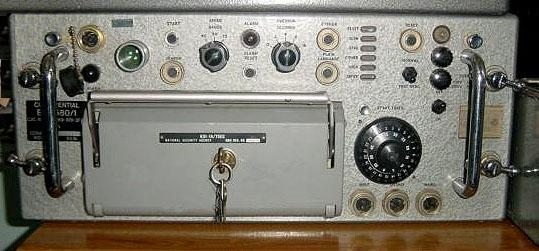 |
| BID580 photo by Godfrey Dykes. Used with permission |
BID/580 (Raleigh) Adrian Wright provides a general description of the BID580. "The principal purpose of the BID580 was to decipher encrypted two tone teletype broadcast messages. It was fitted to all HM Ships and submarines from about 1967 and continued as the main crypto equipment on all RN ships until the early 1980ís. It formed part of the RWA system and was patched in or out of the system with patch leads and a patching panel. The BID580 was receive only and hence, was only used for decrypting broadcast signals. The BID660, however, was the tactical version and was capable of encrypting plain language two tone teletype signals for transmission, or like the BID580, for reception only.The shipborne equipment was very heavy and each unit took two persons to lift. Multiple units were fitted into a 17 inch racks together with a patching panel. All items of Crypto equipment were classified as secret and were designated with the BID prefix. This included such items as Diagnostic Kits, Test Tapes and Crypto cards".
BID580 also saw service aboard the Canadian Argus anti-submarine patrol aircraft. It was fitted at the Radio Operators position and was used to decipher the encrypted Low Frequency broadcast. The system employed a punched card which was placed into a card reader station on the front panel of the machine. It was very similar to the card reader on the TSEC/KWR-37. On closer inspection, the decal on the card reader door does say "National Security Agency".
 |
| BID580 photo by Godfrey Dykes. Used with permission |
Ian Snow , who used the BID580 aboard the Argus remembers this. "The concentric black dials were used for setting the sync time. You dialled in the time and then either then held down the sync button and released it at the correct time (while listening to WWV or CHU) or 'pushed it' at the correct moment. It was a hit and miss operation. You could also put the new card in 5 minutes before crypto zero and it would autosync to a signal sent by the broadcasting station. Getting the 580 synchronized on the tarmac at the base in Summerside PEI was tricky. I've been told it was very difficult to obtain synchronization on the ground at Greenwood due to that base's proximity to the Navy's transmitter site at Newport Corner, N.S. As I recall we 'broke the rules' more than once and launched off without getting the unit locked in. Invariably it synchronized after takeoff. Most of the LF messages destined for the aircraft fell into the category of "I'm calling you on HF - listen up" service messages.The BID 580 was also able to read the broadcast generated by the KWT-37 (Jason) system provided the end users were in possession of the proper keymat.
Credits and References:1) Godfrey Dykes <godfreydykes(at)msn.com>.
Web http://www.rnmuseumradarandcommunications2006.org.uk/Pastel_Album%20NEW%20PICS.html
2) Adrian Wright, HMS Collingwood Museum.
3) Ian Snow <va3qt-4(at)sympatico.ca>]
Jul 18/09